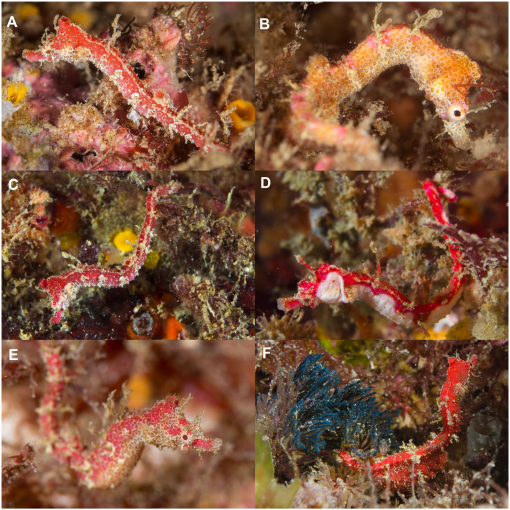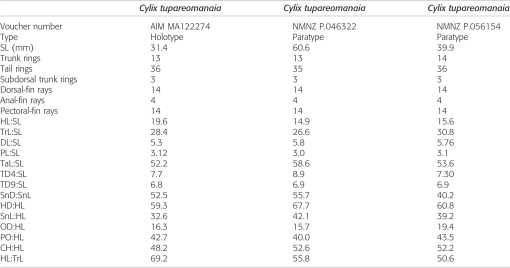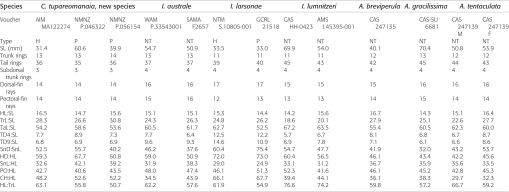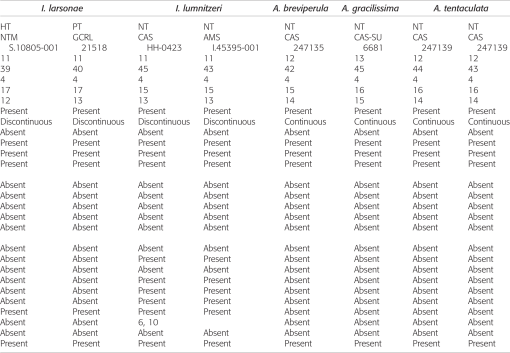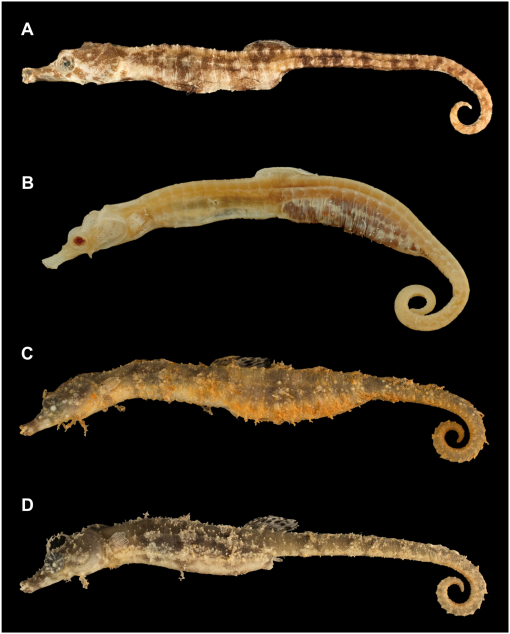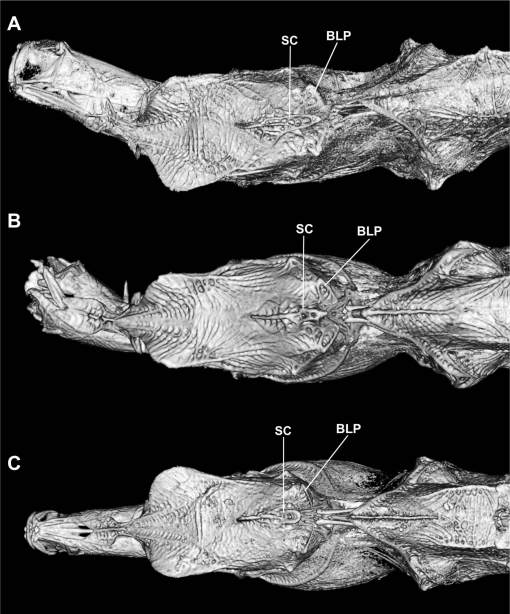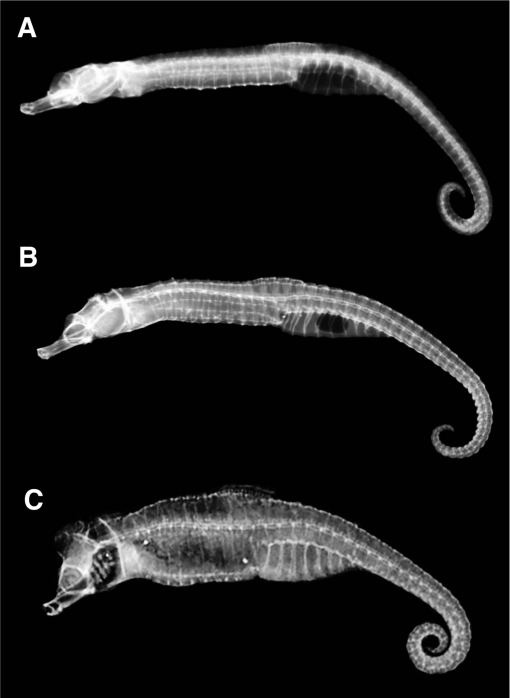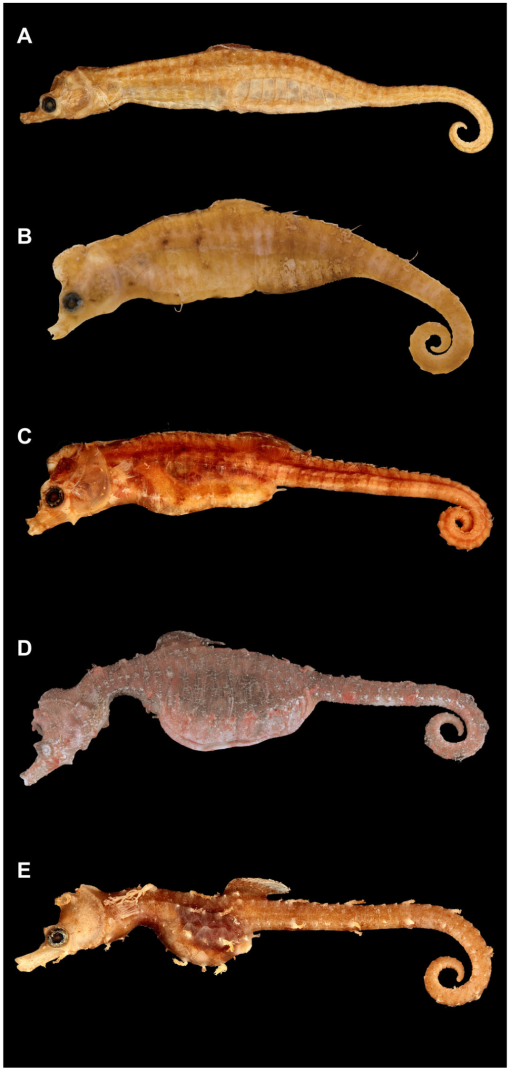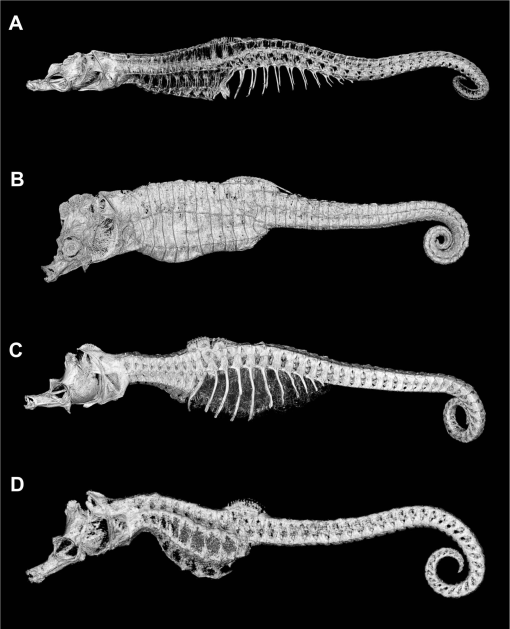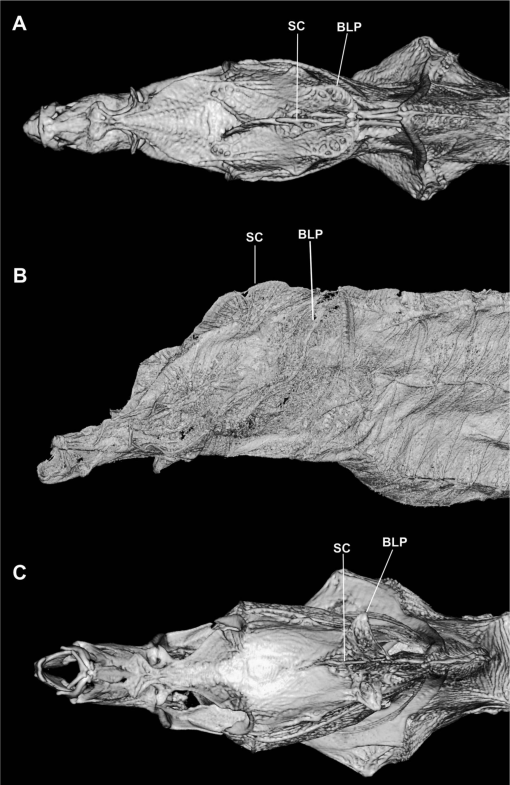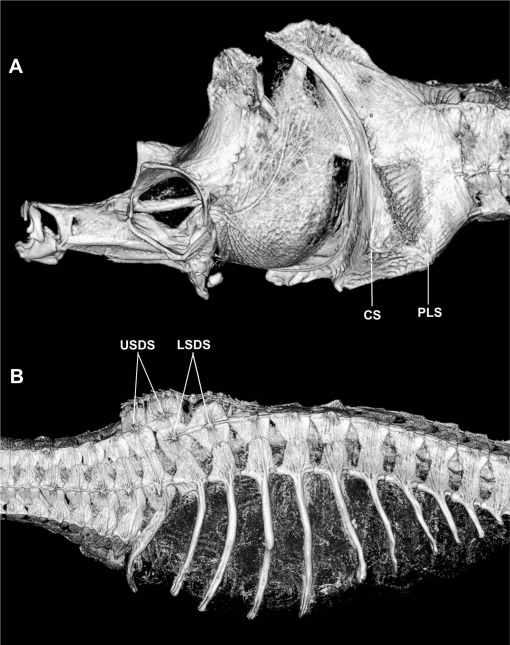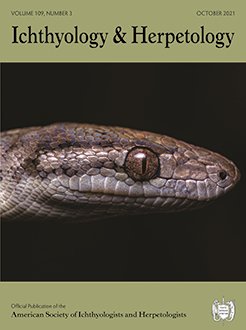Fig. 1
Cylix tupareomanaia. (A) AIM MA122274, female, holotype shortly after death, 31.4 mm SL; Waiatapaua Bay, Whangaruru, Northland, New Zealand (photograph © Auckland Museum). (B) NMNZ P.056154, female, paratype, shortly after death, 35.5 mm SL; Cavalli Islands, Northland, New Zealand (photograph © Irene Middleton).
Fig. 2
Cylix tupareomanaia. (A) AIM MA122274, female, preserved holotype, 31.4 mm SL; Waiatapaua Bay, Whangaruru, Northland, New Zealand (photograph © Auckland Museum). (B) NMNZ P.056154, female, preserved paratype, 35.5 mm SL; Cavalli Islands, Northland, New Zealand (photograph © Auckland Museum). (C) NMNZ P.046322, male, preserved paratype, 55.5 mm SL; east of Oturori Rock, Bay of Islands, Northland, New Zealand (photograph Graham Short).
Fig. 3
Head of Cylix tupareomanaia (AIM MA122274, female, preserved holotype, 31.4 mm SL) in lateral (A), dorsal (B), and ventral (C) view highlighting positions of diagnostic characters, including the cup-like supraoccipital crest present on the supraoccipital, and large medioventral conical spines on the cleithral symphysis and the first trunk ring between the pectoral-fin bases. Abbreviations: CL, cleithral spines; CSS, medioventral conical spine on the cleithral symphysis; DHS, double head spine; FS, frontal spine; LHS, lateral head spine; MVFTRS, medioventral first trunk ring spine between the pectoral-fin bases; ORE, orbital rim extension; PLS, posterolateral spine on pectoral-fin base; PNPC, posterior nuchal plate crest; SC, supraoccipital crest; SnS, snout spines.
Fig. 4
µCT scan of Cylix tupareomanaia, NMNZ P.046322, male, paratype, 55.5 mm SL. (A, B) Anterolateral view of the head highlighting the bifurcated and cup-like crest present on the supraoccipital, continuous cleithral ring, and the strongly elevated ventrolateral bulge of the pectoral-fin base. (C) Anterodorsal aspect of the neurocranium highlighting the bifurcated and cup-like pentamerous bony crest present on the supraoccipital. Abbreviations: FS, frontal spine; PFB, pectoral-fin base; SC, supraoccipital crest; SCL, supracleithrum.
Fig. 5
µCT scan of the ventral aspect of first trunk ring of Cylix tupareomanaia, NMNZ P.046322, male, paratype, 55.5 mm SL, in ventral aspect highlighting positions of large medioventral conical spines on the cleithral symphysis and the first trunk ring between the pectoral-fin bases. Abbreviations: CL, cleithral spines; CSS, medioventral conical spine on the cleithral symphysis; MVFTRS, medioventral first trunk ring spine between the pectoral-fin bases; PLS, posterolateral spine on pectoral-fin base.
Fig. 6
Cylix tupareomanaia in situ. (A) AIM MA122274, female, holotype, Waiatapaua Bay, Whangaruru, Northland, New Zealand, 12 m depth (photograph © Shane Housham). (B) Waiatapaua Bay, Whangaruru, Northland, New Zealand, 12 m depth (photograph © Shane Housham). (C) Waiatapaua Bay, Whangaruru, Northland, New Zealand, 12 m depth (photograph © Richard Smith). (D) Waiatapaua Bay, Whangaruru, Northland, New Zealand, 12 m depth (photograph © Irene Middleton). (E) Waiatapaua Bay, Whangaruru, Northland, New Zealand, 12 m depth (photograph © Irene Middleton). (F) Poor Knights Islands, Northland, New Zealand, at 10 m depth (photograph © Kent Erickson).
Fig. 7
Distribution of Cylix tupareomanaia in Taitokerau Northland, North Island, New Zealand. Square = type locality of holotype AIM MA122274 at Waiatapaua Bay, Whangaruru. Star = locality of paratype NMNZ P.056154, Cavalli Islands. Circle = locality of paratype NMNZ P.046322, east of Oturori Rock, Bay of Islands. Arrow = specimen photographed at Poor Knights Islands.
Table 1
Counts and proportional measurements of type specimens of Cylix tupareomanaia. Ratios are separated by a colon and are listed as percent of SL, HL, or SnL. Abbreviations: CH (coronet height), DL (dorsal-fin length), HD (head depth), HL (head length), OD (orbital height), PL (pectoral-fin length), PO (post-orbital length), SL (standard length), SnD (snout depth), SnL (snout length), TaL (tail length), TD4 (trunk depth between the 4th and 5th trunk rings), TD9 (trunk depth between the 9th and 10th trunk rings), TrL (trunk length).
Table 2
Morphological counts and proportional measurements for type specimens of Cylix tupareomanaia and members of Acentronura and Idiotropiscis. Measurements are in percent SL and HL. Abbreviations: CH (coronet height), H (holotype), HD (head depth), HL (head length), NT (non-type), P (paratype), PO (post-orbital length), SL (standard length), SnD (snout depth), SnL (snout length), TaL (tail length), TD4 (trunk depth between the 4th and 5th trunk rings), TD9 (trunk depth between the 9th and 10th trunk rings), TrL (trunk length). Lines present, from top to bottom, numbers for standard length (SL), counts for trunk rings, tail rings, dorsal and pectoral fins, and proportions.
Table 3
Comparison of meristic and morphometric characters between Cylix tupareomanaia and members of Acentronura and Idiotropiscis. Abbreviations: HT (Holotype), NT (Non-type), PT (Paratype).
Table 4
Summary of the number of trunk rings spanning the brood pouch in male specimens of C. tupareomanaia and members of Acentronura and Idiotropiscis.
Table 5
Morphological character comparisons between Hippocampus and the pygmy pipehorse genera Cylix and Idiotropiscis.
Fig. 8
Lateral view of preserved specimens of Acentronura spp. redescribed in this study. (A) A. breviperula, CAS 247135, female, 40.1 mm SL. (B) A. gracilissima, CAS-SU 6681, male, 70.4 mm SL. (C) A. tentaculata, CAS 247139, male, 50.8 mm SL. (D) A. tentaculata, CAS 247139, female, 53.9 mm SL.
Fig. 9
Lateral view of µCT scanned skeletons of preserved specimens of Acentronura spp. redescribed in this study. (A) A. breviperula, CAS 247135, female, 40.1 mm SL. (B) A. gracilissima, CAS-SU 6681, male, 70.4 mm SL. (C) A. tentaculata, CAS 247139, male, 50.8 mm SL. (D) A. tentaculata, CAS 247139, female, 53.9 mm SL.
Fig. 10.
Dorsal view of µCT scanned neurocranium of (A) Acentronura breviperula, CAS 247135, female; (B) Acentronura gracilissima, CAS 247139, male; (C) Acentronura tentaculata, CAS-SU 6681, male. Abbreviations: BLP, bilateral lobed protuberances; SC, supraoccipital crest.
Fig. 11
X-ray radiography of (A) A. breviperula, BMNH 1890.1.14.51, male, holotype; (B) A. tentaculata, BMNH 1869.6.21.7, male, holotype; (C) I. larsonae, NTM S.10805-001, male, holotype, 55.5 mm SL (Photograph credits for A. breviperula and A. tentaculata to Oliver Crimmen and Ralf Britz, © The Trustees of the Natural History Museum, London; I. larsonae to Michael Hammer, © Museum and Art Gallery of the Northern Territory).
Fig. 12
Lateral view of preserved specimens of Idiotropiscis spp. redescribed in this study. (A) I. australe, WAM P.33543-001, male, 54.7 mm SL. (B) I. larsonae, NTM S.10805-001, male, holotype, 33.5 SL. (C) I. larsonae, GCRL 21518, female, paratype, 33.0 mm SL. (D) I. lumnitzeri, CAS HH-0423, male, 69.9 mm SL. (E) I. lumnitzeri, AMS I.45395-001, female, 54.0 mm SL.
Fig. 13
Lateral view of µCT scanned skeletons of preserved specimens of Idiotropiscis spp. redescribed in this study. (A) I. australe, WAM P.33543-001, male, 54.7 mm SL. (B) I. larsonae, GCRL 21518, female, paratype, 33.0 mm SL. (C) I. lumnitzeri, CAS HH-0423, male, 69.9 mm SL. (D) I. lumnitzeri, AMS I.45395-001, female, 54.0 mm SL.
Fig. 14
Dorsal view of µCT scanned neurocranium of the head of (A) Idiotropiscis australe, WAM P.33543-001, male; (B) Idiotropiscis larsonae, GCRL 21518, male; (C) Idiotropiscis lumnitzeri, CAS HH-0423, male. Abbreviations: BLP, bilateral lobed protuberances; SC, supraoccipital crest.
Fig. 15
µCT scanned skeleton of Idiotropiscis lumnitzeri, CAS HH-0423, male, 69.9 mm SL. (A) Osteocranium in lateral view highlighting the ventral cleithral cheek spine and small spine posteroventral of pectoral-fin base. (B) Subdorsal-fin base in lateral view highlighting the one upper and one lower subdorsal spines. Abbreviations: CS, cleithral spine; LSDS, lower subdorsal spine; PLS, posterolateral spine on pectoral-fin base; USDS, upper subdorsal spine.
Fig. 16
Lateral view of µCT scanned neurocranium of (A) Cylix tupareomanaia, NMNZ P.046322; (B) Hippocampus barbouri, USNM 220605. Abbreviations: ANP, anterior nuchal plate; CO, coronet on anterior nuchal plate; PNP, posterior nuchal plate; SC, supracleithrum; SOC, supraoccipital.
Fig. 17
Phylogenetic hypothesis using nuclear gene sequences TMO-4C4 and 18S retrieved with Maximum Likelihood (ML), Maximum Parsimony (MP), and Bayesian Inference (MrBayes), representing 17 species from clade 6 from the analysis of Hamilton et al. (2017) and the new taxon. Tree rooted with the southern Australian trunk-brooder pipefish Heraldia nocturna. Nodal support at the generic level is shown in ML/MP/MrBayes order. See Data Accessibility for tree file.
Table 6
Uncorrected genetic distances (p-distances) summary between C. tupareomanaia and species of Acentronura and Idiotropiscis based on cytochrome c oxidase I (COI) sequences analyzed in this study.
Appendix 1
GenBank numbers associated with mtDNA (COI) and nDNA (18S, TMO-4C4) sequences used in this study.






